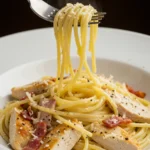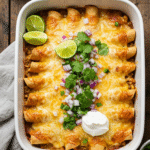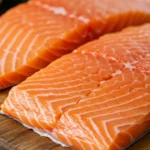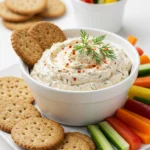Follow Me On Social Media!
chicken carbonara recipe
There’s something absolutely magical about twirling silky pasta strands coated in a rich, golden sauce that clings perfectly to every bite. That first forkful of perfectly executed chicken carbonara – with its creamy texture, smoky pancetta, and tender chicken – is pure comfort food heaven. But let’s be honest, we’ve all been there: standing over a pan of what was supposed to be carbonara, only to find ourselves with expensive scrambled eggs instead.
I’m Bella, and after years of perfecting this beloved Italian classic (and yes, making plenty of mistakes along the way!), I’m here to share the chicken carbonara recipe that will never let you down. Whether you’re a traditionalist who swears by the authentic Roman method or someone who loves a creamy twist, I’ve got you covered with foolproof techniques and insider secrets that guarantee silky, restaurant-quality results every single time.
The Great Carbonara Debate: Cream vs. No Cream
Let me settle this once and for all – the traditional Roman carbonara doesn’t use cream, and there’s good reason for that! The authentic method creates its own luxurious creaminess through the magical emulsion of eggs, cheese, and starchy pasta water. It’s all about technique, timing, and a little bit of pasta alchemy.
That said, I completely understand why many home cooks gravitate toward cream-based versions. Adding cream provides a safety net that prevents curdling and creates that instantly recognizable rich texture we all crave. There’s absolutely nothing wrong with preferring an easy chicken carbonara recipe that uses cream – it’s still delicious and considerably more forgiving for beginners.
The beauty of cooking lies in making dishes that bring you joy. If you’re hosting a dinner party and want to guarantee smooth results, go with cream. If you’re feeling adventurous and want to master the traditional technique, skip it. Both versions deserve a place at your dinner table, and I’ll show you exactly how to nail each one.
Ingredients and Equipment
For the Classic Chicken Carbonara:
- 1 lb spaghetti or linguine
- 1 pound of boneless, skinless chicken thighs, chopped into bite-sized pieces
- 6 oz pancetta or guanciale, diced
- 4 large egg yolks
- 1 whole egg
- 1 cup freshly grated Pecorino Romano cheese
- ½ cup freshly grated Parmigiano-Reggiano
- 2 cloves garlic, minced
- Freshly cracked black pepper
- Salt for pasta water
- 2 tablespoons olive oil
For the Creamy Chicken Carbonara:
- All ingredients above, plus:
- ½ cup heavy cream
- 2 tablespoons butter
Essential Equipment:
- Large pot for pasta
- Heavy-bottomed skillet or sauté pan
- Fine-mesh strainer
- Large mixing bowl
- Whisk
- Pasta serving bowls
- Ladle for pasta water
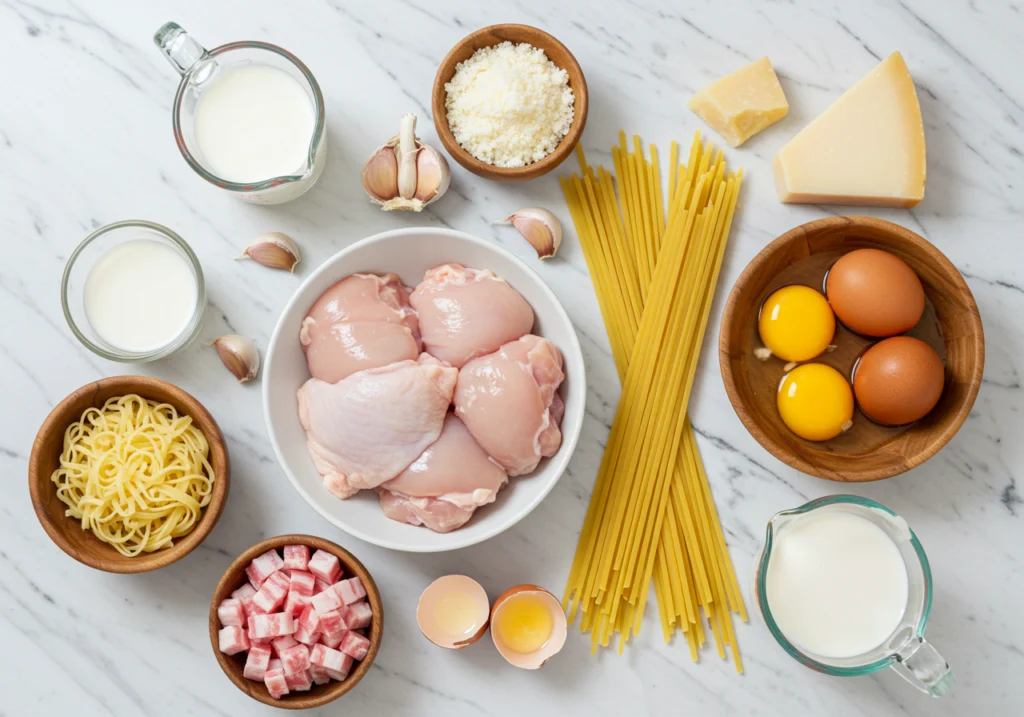
Step-by-Step Instructions
Step 1: Prep Your Mise en Place Before you even think about turning on the stove, get everything ready. Dice your pancetta, cut your chicken into uniform pieces, and grate your cheese fresh (trust me, pre-grated won’t give you the same silky results). In a large bowl, combine the egg yolks with the whole egg and whisk until well blended.
Step 2: Get That Pasta Water Going Fill your largest pot with water and salt it generously – it should taste like the sea. Bring it to a rolling boil. This is going to be your secret weapon for creating that perfect sauce consistency.
Step 3: Cook the Pancetta Warm a skillet over medium heat, then add the diced pancetta. Cook for 4-5 minutes until it’s golden and crispy, and all that beautiful fat has rendered out. Remove with a slotted spoon but leave that liquid gold in the pan!
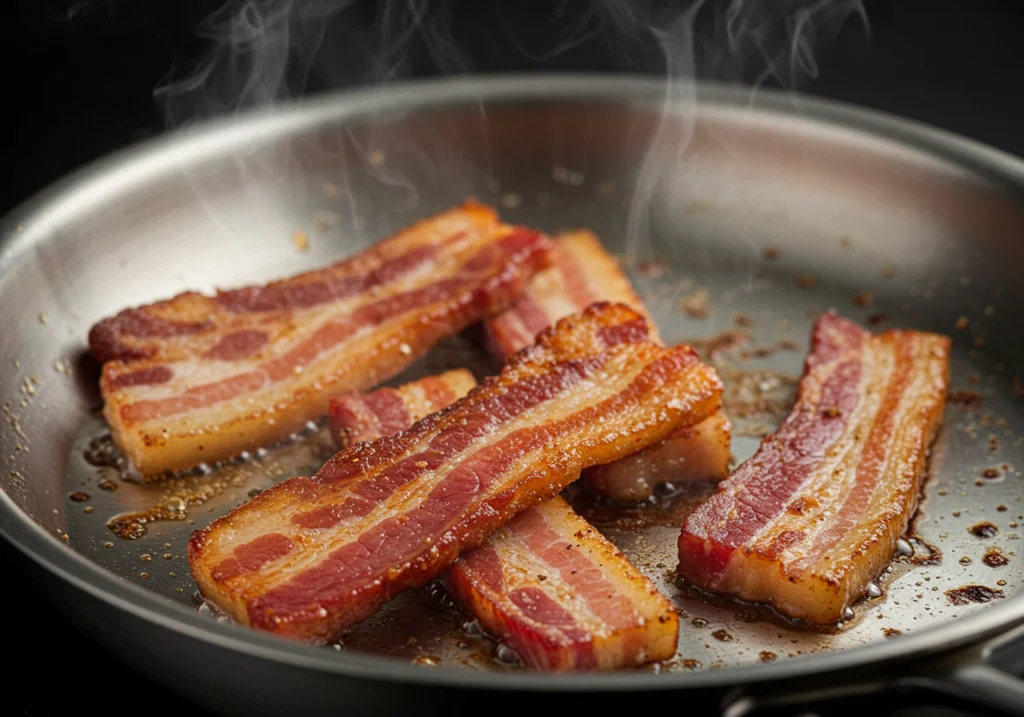
Step 4: Cook the Chicken Lightly season the chicken pieces with salt and pepper, then place them in the pancetta drippings. Cook for 6–8 minutes, turning as needed, until they are golden brown and fully cooked through. Add the minced garlic in the last minute – you want it fragrant, not burnt.
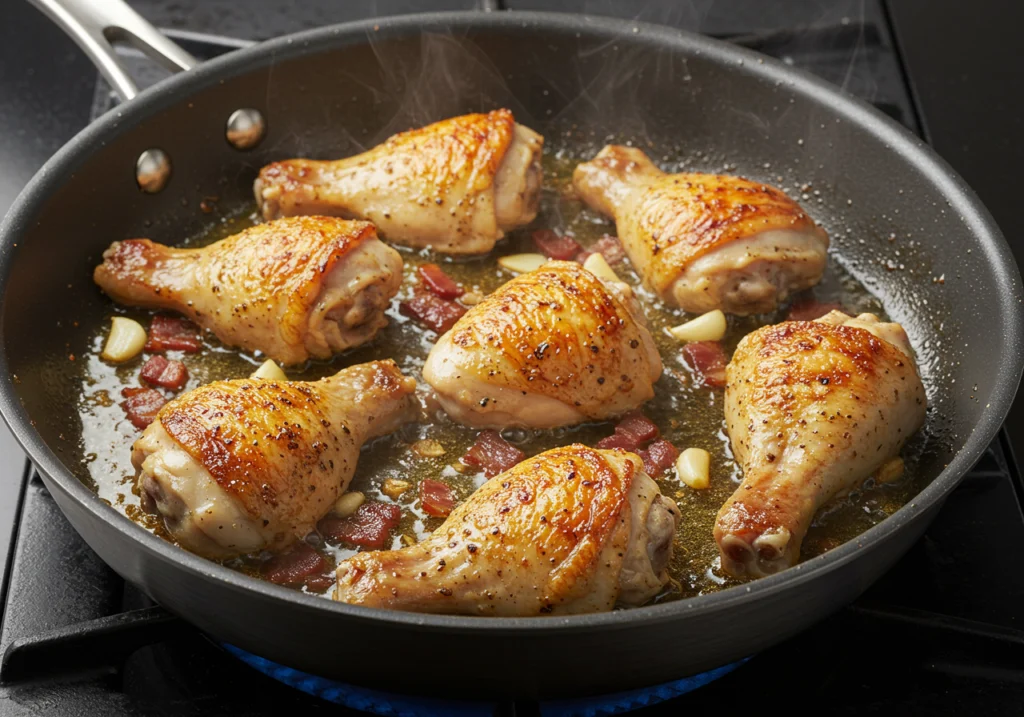
Step 5: Cook the Pasta Drop your pasta into that boiling water and cook it one minute less than the package directions. Cook it al dente, since it will continue cooking in the sauce.
Step 6: Create the Sauce Base While the pasta cooks, whisk your grated cheese into the egg mixture along with plenty of freshly cracked pepper. This is where the magic starts happening!
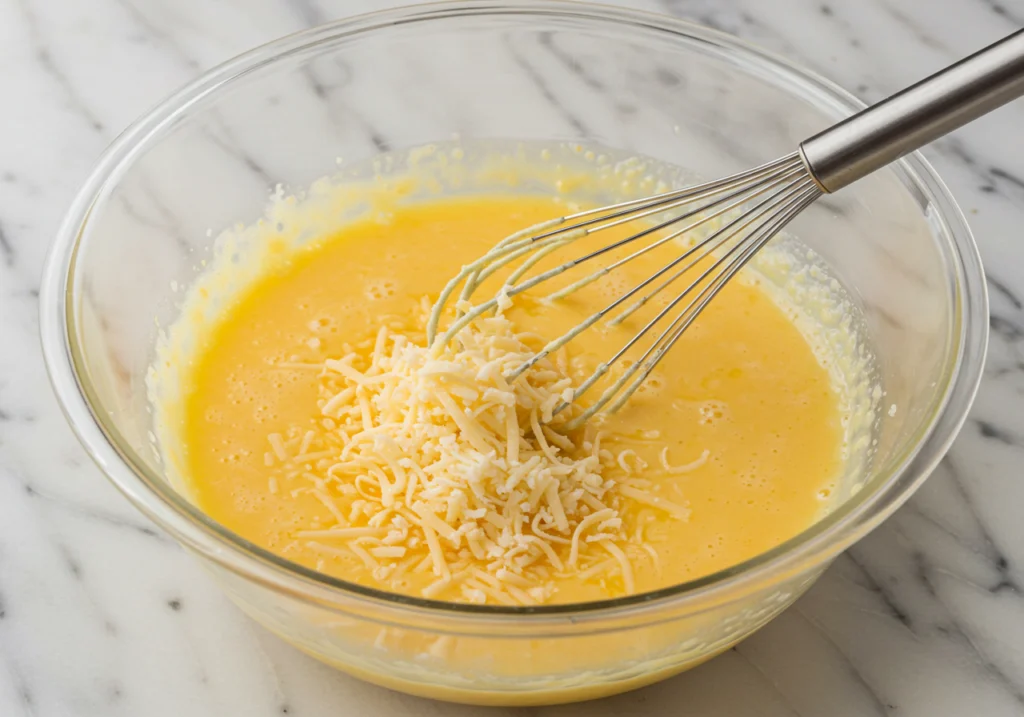
Step 7: The Key Step (No-Cream Method) Before draining, save about 2 cups of the pasta’s cooking water. Drain the pasta, then immediately add it, still hot, to the pan with the chicken and pancetta. Remove from heat, then slowly drizzle in your egg mixture while tossing constantly. Add pasta water gradually until you achieve that glossy, creamy coating.
Step 8 Alternative: The Cream Version For the creamy chicken carbonara, add the cream and butter to your chicken and pancetta, then stir in the egg mixture off the heat. This method is much more forgiving and still incredibly delicious.
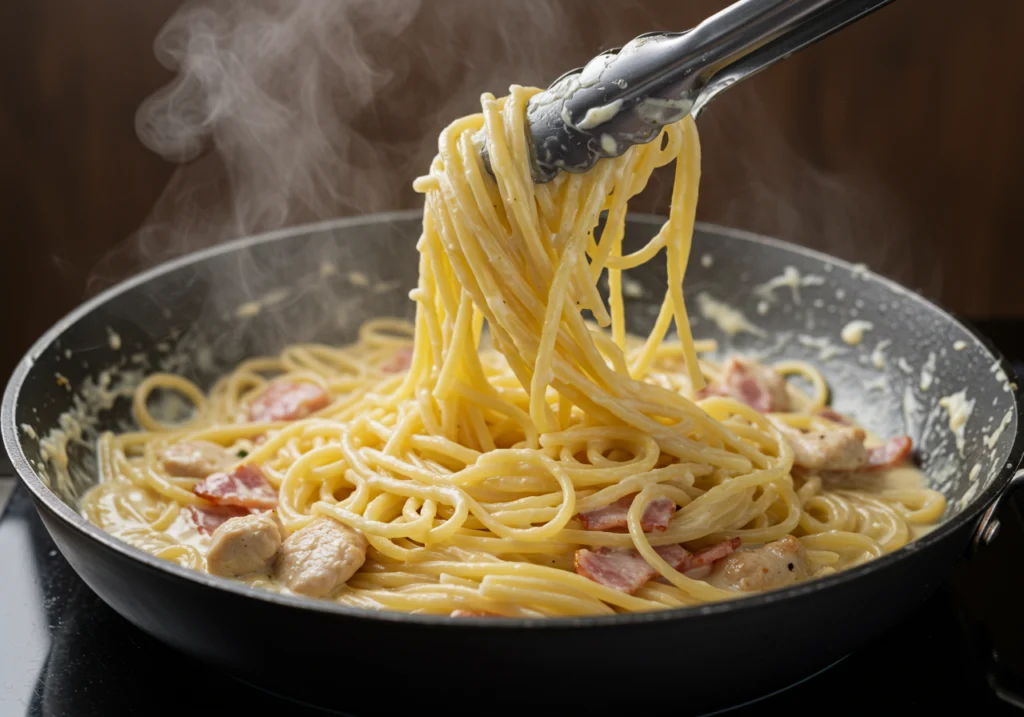
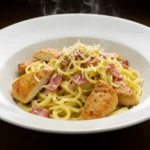
The Only Chicken Carbonara Recipe You’ll Ever Need (Easy, Creamy & Authentic Options)
- Total Time: 35 minutes
- Yield: 4–6 servings 1x
- Diet: Gluten Free
Description
This foolproof chicken carbonara recipe delivers restaurant-quality results with silky, creamy sauce that never scrambles. Choose between traditional Roman-style or cream-enhanced versions, both featuring tender chicken, crispy pancetta, and perfectly cooked pasta in a rich, golden sauce.
Ingredients
- 1 lb spaghetti or linguine
- 1 lb boneless, skinless chicken thighs, cut into bite-sized pieces
- 6 oz pancetta or guanciale, diced
- 4 large egg yolks
- 1 whole egg
- 1 cup freshly grated Pecorino Romano cheese
- ½ cup freshly grated Parmigiano-Reggiano
- 2 cloves garlic, minced
- Freshly cracked black pepper
- Salt for pasta water
- 2 tablespoons olive oil
- ½ cup heavy cream (optional, for creamy version)
- 2 tablespoons butter (optional, for creamy version)
Instructions
- Bring large pot of salted water to boil for pasta.
- Heat skillet over medium heat, cook pancetta until crispy, 4-5 minutes. Remove, keep fat in pan.
- Season chicken with salt and pepper, cook in pancetta fat until golden, 6-8 minutes. Add garlic last minute.
- Whisk egg yolks, whole egg, and grated cheeses in large bowl with black pepper.
- Cook pasta 1 minute less than package directions. Reserve 2 cups pasta water.
- Add drained pasta to chicken and pancetta. Remove from heat.
- Traditional: Slowly add egg mixture while tossing, gradually add pasta water until creamy.
- Creamy version: Add cream and butter, then stir in egg mixture off heat.
- Serve immediately with extra cheese and black pepper.
Notes
- Always remove pan from heat before adding egg mixture to prevent scrambling
- Use room temperature eggs for smoother mixing
- Pasta water is crucial for proper sauce consistency
- Fresh grated cheese melts better than pre-grated
- Best served immediately while hot
- Prep Time: 15 minutes
- Cook Time: 20 minutes
- Category: Main Course, Pasta
- Method: Stovetop, Sautéing
- Cuisine: Italian, Italian-American
Nutrition
- Serving Size: 1 cup (approximately 300g)
- Calories: 685
- Sugar: 3g
- Sodium: 1,240mg
- Fat: 32g
- Saturated Fat: 14g
- Unsaturated Fat: 16g
- Trans Fat: 0g
- Carbohydrates: 58g
- Fiber: 3g
- Protein: 42g
- Cholesterol: 285mg
Keywords: chicken carbonara recipe, easy chicken carbonara, creamy chicken carbonara, best chicken carbonara recipe, Italian pasta recipe, chicken pasta, carbonara sauce, homemade carbonara
Pro-Tips for Success:
- The Secret to Silky, Not Scrambled, Eggs: Always remove the pan from heat before adding your egg mixture, and never stop moving that pasta!
- Temperature Control: If your pan is too hot, you’ll get scrambled eggs instead of sauce. When in doubt, take it off the heat.
- Pasta Water is Liquid Gold: That starchy water is what creates the perfect sauce consistency. Don’t skip this step!
Expert Tips for Carbonara Perfection
Here are my insider secrets for achieving best chicken carbonara recipe results every time:
• Master the pasta water ratio: Start with less and add more gradually. You can always add more liquid, but you can’t take it away once your sauce becomes too thin.
• Choose the right pasta shape: Long noodles like spaghetti, linguine, or fettuccine work best because they hold onto that creamy sauce beautifully.
• Fresh cheese is non-negotiable: Pre-grated cheese contains anti-caking agents that prevent smooth melting. Always grate Pecorino Romano and Parmigiano-Reggiano fresh.
• Room temperature eggs mix better: Take your eggs out of the fridge 30 minutes before cooking to prevent temperature shock when combining with hot ingredients.
• Don’t rush the pancetta: Properly rendered pancetta should be golden and crispy. This takes patience, but it’s worth every second for that smoky flavor.
• Reheat with care: Leftover carbonara can be tricky, but a splash of cream and gentle reheating in a double boiler can bring it back to life.
Variations and Customizations
Ready to add your own twist to this classic? Here are some delicious variations that’ll keep your family excited about dinner:
Spicy Chicken Carbonara: Add ½ teaspoon of red pepper flakes when you’re cooking the pancetta. The heat pairs beautifully with the rich, creamy sauce and adds a nice kick without overwhelming the dish.
Mushroom and Chicken Carbonara: Sauté 8 oz of mixed mushrooms (cremini and shiitake work wonderfully) until golden brown, then add them back with the chicken. The earthy mushroom flavor creates incredible depth.
Lighter Chicken Carbonara: Use chicken breast instead of thighs, turkey bacon instead of pancetta, and substitute half the egg yolks with whole eggs. You’ll cut calories without sacrificing too much of that signature richness.
Vegetable-Packed Version: Add blanched peas, asparagus tips, or baby spinach in the last minute of cooking for extra nutrition and color.
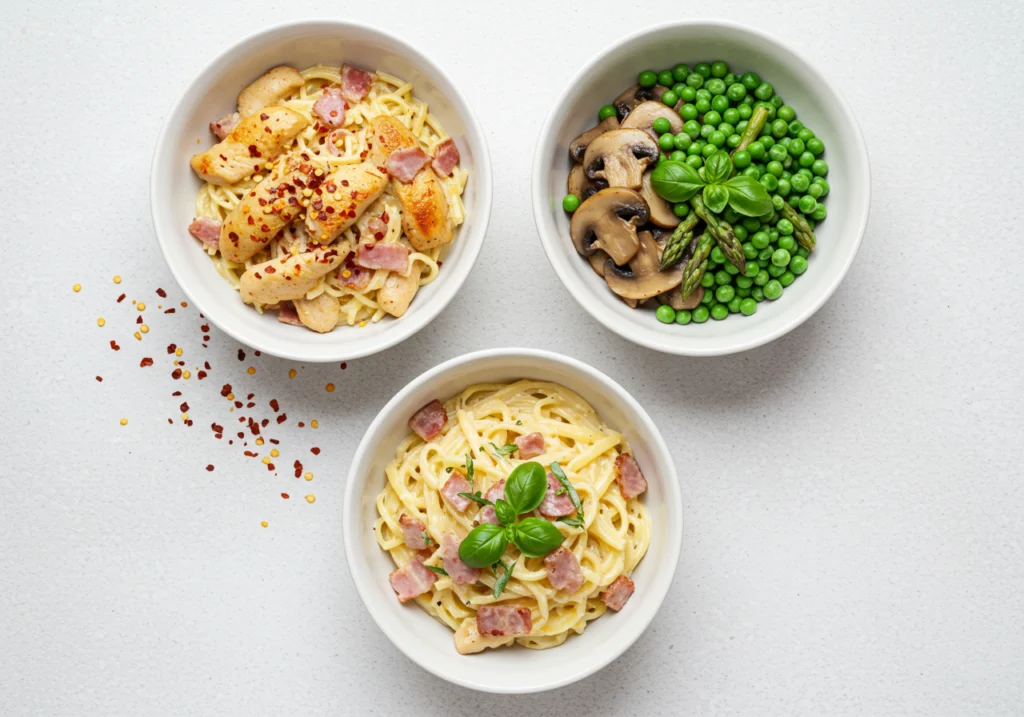
Frequently Asked Questions
Can I use bacon instead of pancetta? Absolutely! While pancetta is traditional and has a milder, more delicate flavor, bacon works beautifully and adds a smoky element that many people prefer.
Are raw eggs safe to eat in carbonara? The eggs aren’t technically raw – they’re gently cooked by the heat of the pasta and the warm pan. However, if you’re concerned, you can use pasteurized eggs or the cream version for extra peace of mind.
What can I serve with chicken carbonara? Keep it simple! A crisp Caesar salad, garlic bread, and a glass of Pinot Grigio or Chardonnay complement the rich flavors perfectly without competing.
How do I store leftover carbonara? Carbonara is definitely best fresh, but leftovers will keep in the fridge for 2-3 days. Warm it up slowly, adding a little cream or pasta water to bring back the creamy consistency.
Can I make this ahead of time? While carbonara is meant to be served immediately, you can prep all your ingredients in advance. Cook the pancetta and chicken, grate the cheese, and have everything ready to go for quick assembly.
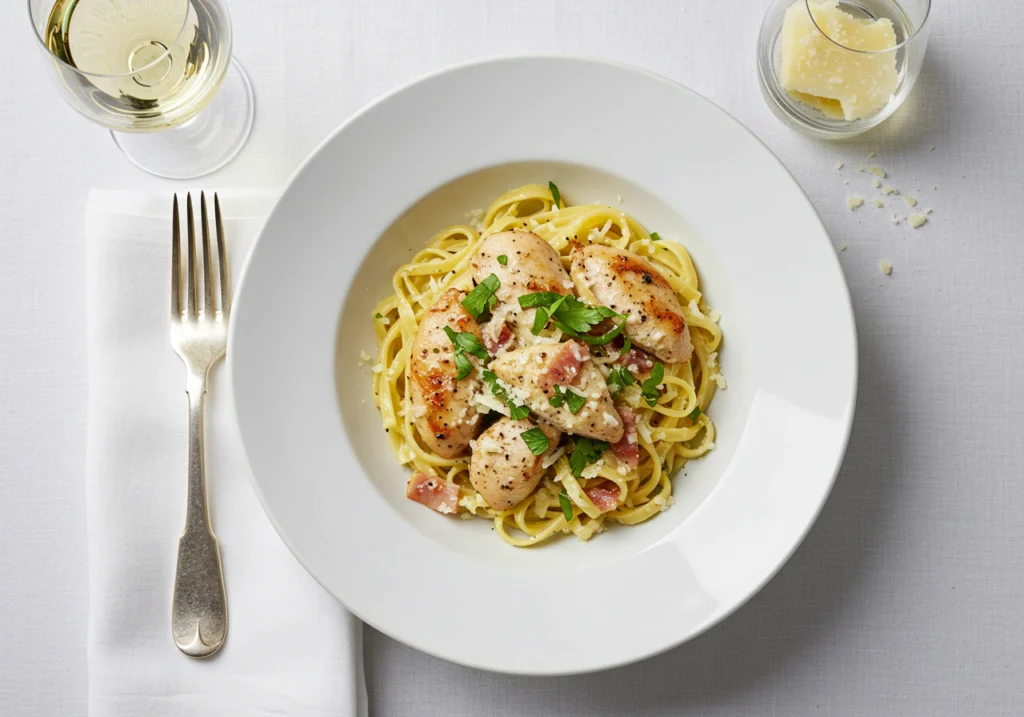
Conclusion
The secret to perfect chicken carbonara isn’t just in the technique – it’s in understanding that cooking should bring you joy, not stress. Whether you choose the traditional Roman method or prefer the safety net of cream, what matters most is creating something delicious that brings people together around your table.
Remember, even if your first attempt isn’t picture-perfect, each attempt teaches you something new about timing, temperature, and technique. That’s the beauty of cooking – it’s a journey, not a destination.
Call to Action
Ready to become the carbonara master in your kitchen? Give this recipe a try this weekend and let me know how it turns out! I’d love to see your creations – share your photos on social media using #BellasCarbonaraSuccess.
Craving more fail-safe Italian recipes? Get them delivered straight to your inbox! Subscribe to my newsletter for weekly recipe inspiration, cooking tips, and exclusive content you won’t find anywhere else. Trust me, your weeknight dinners will never be boring again!

